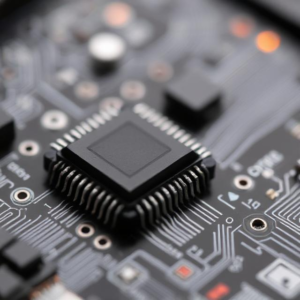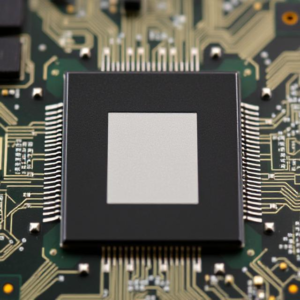What is a Temperature Sensor?
A temperature sensor is a device that measures the temperature of an object or environment. In electronics, temperature sensors are used to detect and monitor temperatures in various systems like computers, appliances, cars, and industrial machines.
For example:
- A thermometer in your home measures the temperature of the air.
- A temperature sensor in your computer’s CPU checks how hot the processor is so that it can prevent overheating.

Why Do We Need Temperature Sensors?
Temperature sensors are important because many electronic systems and devices rely on temperature control to function properly. If the temperature is too high or too low, the system may malfunction or get damaged.
For example:
- Overheating in a smartphone can cause it to shut down to prevent damage.
- Overheating in a computer’s CPU can cause it to crash or slow down.
- In industrial machinery, temperature sensors help ensure the equipment operates within safe temperature limits.
How Do Temperature Sensors Work?
Temperature sensors work by converting the temperature into an electrical signal that can be measured. There are different types of temperature sensors, each working in a slightly different way, but they all follow this basic idea of converting temperature to a measurable signal.
Types of Temperature Sensors
There are several common types of temperature sensors used in electronics, each suited for different applications:
- Thermistors:
- What are they?: A thermistor is a type of resistor whose resistance changes with temperature. It’s made from special materials (usually ceramic) that have a predictable resistance change as the temperature changes.
- How do they work?: As the temperature increases or decreases, the resistance of the thermistor changes. By measuring this resistance, we can calculate the temperature.
- Example: In many temperature-sensitive devices (like battery-powered devices), thermistors are used to monitor and control temperature.
- Types:
- NTC (Negative Temperature Coefficient): As the temperature increases, the resistance decreases.
- PTC (Positive Temperature Coefficient): As the temperature increases, the resistance increases.
- Thermocouples:
- What are they?: A thermocouple consists of two different types of metal wires joined at one end. When this junction is heated or cooled, it creates a small voltage, which can be measured and related to the temperature.
- How do they work?: The temperature difference between the two metal wires generates a voltage that can be measured. The amount of voltage corresponds to the temperature difference between the junction and the other ends of the wires.
- Example: Thermocouples are often used in industrial applications, such as measuring the temperature of furnaces or engines.
- Advantages: They can measure a wide range of temperatures and are often used in high-temperature environments.
- RTDs (Resistance Temperature Detectors):
- What are they?: An RTD is a type of temperature sensor made from pure metals (usually platinum). Its resistance increases predictably with temperature, allowing us to measure the temperature accurately.
- How do they work?: Like thermistors, RTDs change resistance with temperature. However, RTDs offer higher accuracy and stability, especially at higher temperatures.
- Example: RTDs are used in precision applications, like in laboratories or industries where accurate temperature measurement is important.
- Advantages: RTDs are accurate and stable over a wide range of temperatures, and they offer excellent performance.
- Semiconductor Temperature Sensors:
- What are they?: These sensors are made using semiconductor materials (like silicon) and work by detecting changes in the voltage or current as the temperature changes.
- How do they work?: Semiconductor sensors produce a current or voltage that varies with temperature. By measuring this electrical signal, the temperature can be calculated.
- Example: Semiconductor sensors are commonly used in consumer electronics like smartphones or microcontrollers.
- Infrared (IR) Temperature Sensors:
- What are they?: IR sensors detect infrared radiation (heat) emitted by objects, which is related to their temperature.
- How do they work?: These sensors measure the infrared radiation from the object and calculate the temperature based on the intensity of the radiation.
- Example: IR temperature sensors are used in applications like non-contact thermometers or temperature monitoring of objects that are difficult to touch (like hot machinery).
- Advantages: They allow for remote temperature measurement, meaning you don’t need to physically touch the object to measure its temperature.
How Are Temperature Sensors Used in Electronics?
Temperature sensors are used in a wide variety of electronic devices and systems to monitor and manage temperature. Here are some common applications:
- Computers and Smartphones:
- Temperature sensors monitor the heat generated by the CPU, GPU, and battery. If the temperature gets too high, the system can slow down or shut down to prevent overheating.
- Consumer Electronics:
- Temperature sensors are used in devices like refrigerators, air conditioners, and ovens to regulate the temperature inside the device.
- Industrial Systems:
- In manufacturing or industrial machinery, temperature sensors help ensure that equipment operates at safe temperatures to avoid damage.
- Medical Devices:
- Temperature sensors are used in medical devices like thermometers and incubators to monitor the body temperature of patients or ensure that devices are operating in the correct temperature range.
- Environmental Monitoring:
- Sensors are used in weather stations or smart home systems to measure and monitor the temperature of the environment.
Advantages of Temperature Sensors
- Accuracy:
- Temperature sensors, like RTDs or thermocouples, offer highly accurate measurements of temperature, making them essential for precise applications.
- Reliability:
- Many temperature sensors are durable and can operate reliably in harsh conditions (e.g., in industrial environments or extreme temperatures).
- Low Power Consumption:
- Certain temperature sensors (like semiconductor sensors) are designed to consume very little power, which is important for battery-powered devices.
- Versatility:
- Temperature sensors come in many types and sizes, making them suitable for a wide range of applications, from consumer gadgets to industrial machinery.
Disadvantages of Temperature Sensors
- Cost:
- Some types of temperature sensors, like RTDs, can be more expensive than simpler sensors like thermistors.
- Sensitivity:
- Some sensors may be more sensitive to environmental conditions (e.g., humidity or pressure) and might require extra calibration or compensation.
- Range:
- Some temperature sensors, like thermistors, might only be useful in a limited temperature range, whereas others (like thermocouples) can handle very high temperatures.
In Simple Terms:
A temperature sensor in electronics measures how hot or cold something is and converts that into an electrical signal that the system can read. There are different types of temperature sensors, such as thermistors, thermocouples, RTDs, semiconductor sensors, and infrared sensors, each used for different applications based on how they work and their accuracy.
- Thermistors are good for general use and are affordable.
- Thermocouples can measure very high temperatures, making them great for industrial applications.
- RTDs are accurate and stable, often used for precise measurements.
- Semiconductor sensors are commonly found in consumer electronics like smartphones.
- Infrared sensors allow for measuring temperature without touching the object, ideal for non-contact applications.
These sensors are used in everyday devices, like computers, refrigerators, medical tools, and industrial machinery, to ensure everything works within the right temperature range.











